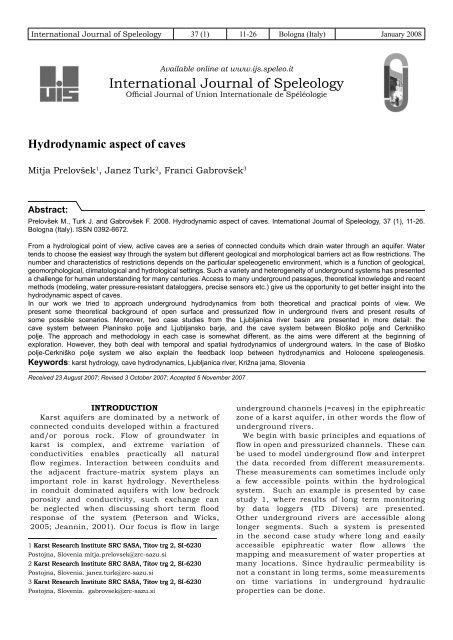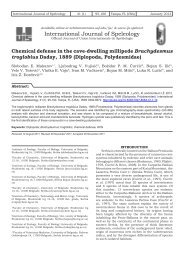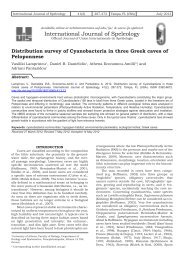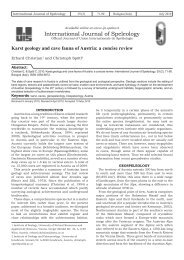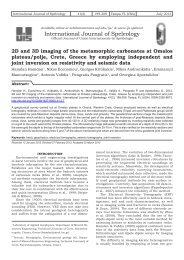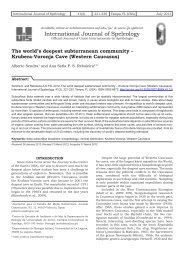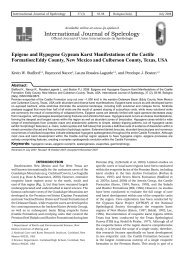Hydrodynamic aspect of caves - ResearchGate
Hydrodynamic aspect of caves - ResearchGate
Hydrodynamic aspect of caves - ResearchGate
Create successful ePaper yourself
Turn your PDF publications into a flip-book with our unique Google optimized e-Paper software.
<strong>Hydrodynamic</strong> <strong>aspect</strong> <strong>of</strong> <strong>caves</strong>13The most radical approximation <strong>of</strong> the Saint-Venantequation is a steady state one. All that is left frommass and momentum conservation is the Manning’sequation (Eq. 5.)Steady state equations for open channel and fullpipe flowUnderground rivers experience transitions topressurized (full pipe) flow. Manning’s equation can beapplied also for pressurized flow, but more <strong>of</strong>ten theDarcy-Weisbach equation is used, where the frictionhead loss per unit length is given by:(7)j =2Qf2⋅D ⋅ AD is hydraulic radius, g gravitational acceleration,and f the friction factor.As a general rule, steady state relations for the headloss can be written as a power law <strong>of</strong> the type j= K·Q m(Larock et al., 2000), where K and m change dependingon the particular equation used (e.g. Manning, Darcy-Weisbach, Hazen Williams).Rozos and Koutsoyiannis (2006) introduced aManning type equation which accounts for the steadystate free surface and pressurized flow:(8)b ⎛ h ⎞Q = ⎜ ⎟n ⎝ D ⎠D is the height <strong>of</strong> the conduit. Parameters α and βare obtained numerically and depend on the geometry<strong>of</strong> cross-section and hydraulic radius.Jeannin (2001) successfully applied the Darcy-Weisbach equation to model flow in the lower part <strong>of</strong>the Hölloch system in Switzerland.Friction factorsManning’s n for “streams with no vegetation withsteep banks and bottom covered with cobbles andboulders” has values between 0.03 and 0.07 (Dingman,2002). Wall roughness in karst conduits shows largevariability. The friction factor f in the Darcy-Weisbachequation is discussed by several authors. Gale(1984) obtained hydraulic conditions and parametersbased on the analysis <strong>of</strong> rock dissolution forms andsediments. From scallop distributions he obtained afriction factor <strong>of</strong> the scalloped walls between 0.04 to0.13 from different locations. From studies <strong>of</strong> fluidtransportedsediments in Fissure ave (U.K.) heobtained f = 0.17.Besides wall friction, other sources <strong>of</strong> head lossare present along the course <strong>of</strong> a river. These includeentrance losses, where water enters conduit from alarge pool (reservoir), sudden and gradual expansionand contraction losses, where cross-section changes(Springer, 2004), losses at bends etc. These losses aregenerally written in the form K(v 2 /2g).ai1/ 2.Use <strong>of</strong> SWMM to model the hydrodynamics inepiphreatic zoneTo demonstrate some <strong>of</strong> the theory, we present a fewsimple examples where listed formulae come into action.To this extent we will apply the Storm Water ManagementModel (SWMM) which is primarily designed to simulate flowand transport in sewer systems (Rossman, 2007). SWMMhas been successfully used for karst drainage systemswhere the conduit geometry is well known (ampbell andSullivan, 2002; Peterson and Wicks, 2006). Here we use it“uncritically” to present a few scenarios which demonstratesome <strong>of</strong> the typical behavior expected in karst systems.There are many examples where a river sinks undergroundinto large conduits and runs into a restriction. A modelingscenario for such case is presented in Fig. 1a.The input into the system increases slowly enough tomeet steady state conditions.Fig. 1b shows the level <strong>of</strong> the water at the entrance<strong>of</strong> the restriction when depending on the flow rate. Theconduit representing restriction is 2 m high and 5 m wide.Manning’s roughness coefficient is 0.05.Initially the level rises following the relation for openchannels (see Eq.5). When the conduit becomes pressurizedthe level increases with a higher power <strong>of</strong> flow, normallybetween 1 and 2. Gabrovšek and Peric (2006) usedsimilar models to interpret data obtained by continuousmonitoring <strong>of</strong> flow and water levels in the <strong>caves</strong>.The details <strong>of</strong> the transition from free surface topressurized flow becomes complex and is beyond the scope<strong>of</strong> this paper and probably irrelevant for karst conduits.The course <strong>of</strong> an underground river can include manyrestrictions and large channels or chambers that actas storage reservoirs. A simple scenario with a series <strong>of</strong>chambers (= storage reservoirs) and conduits is shown inFig. 2. All conduits have length <strong>of</strong> 200 m, they are 5 mwide. Their height is 4, 2 and 1 m from upper to lowerchannel, respectively. A triangular flow hydrogram asshown on Fig. 2b is introduced to the system. Levels h 1,h 2, h 3in the reservoir are initially linked to the free surfacelevels in the conduits, but rise steeply once the conduitsbecome pressurized. Similar systems <strong>of</strong> reservoir andFig. 1. a) Model <strong>of</strong> large conduit ending with restriction. b)Dependence <strong>of</strong> a level at the entrance <strong>of</strong> restriction on recharge.International Journal <strong>of</strong> Speleology, 37 (1), 11-26. Bologna (Italy). January 2008
14Mitja Prelovšek, Janez Turk, Franci GabrovšekFig. 2. Model <strong>of</strong> a series <strong>of</strong> chambers (storage reservoirs) withconnecting conduits. b) Flow hydrogram at the entrance <strong>of</strong> the systemand level hydrograms in the chambers.restriction were discussed by Halihan and Wicks (1998)who used it to model the storm response <strong>of</strong> cave systemin Missouri, USA.Time variation <strong>of</strong> hydraulic propertiesHydraulic properties <strong>of</strong> karst conduits change in time.Short term changes are consequence <strong>of</strong> breakdown,sedimentation, and flotsam transport. These changescan occur within a very short time span, e.g. single floodevent.Long term changes are the consequence <strong>of</strong> dissolutionand flowstone deposition processes. Such an examplecan be seen in Križna jama where a series <strong>of</strong> flowstonedams considerably changes the hydrodynamics <strong>of</strong> flow.The lakes behind the dams act as a series <strong>of</strong> storagereservoirs which dampens the flood response.CASE STUDY 1: HYDRODYNAMICS OFUNDERGROUND WATER FLOW BETWEENPLANINSKO POLJE AND LJUBLJANICASPRINGSIntroductionSeveral methods were used to assume hydrodynamic<strong>of</strong> underground flow in karst areas. We studiedcharacteristics and behavior <strong>of</strong> underground flowaccording to two parameters: the water level in <strong>caves</strong>and discharge <strong>of</strong> surface river as a simplified source<strong>of</strong> input. For more detailed interpretation hydraulicgradients between studied areas should also be takeninto consideration.We observed the response <strong>of</strong> epiphreatic zone ondefined flood pulses as a consequence <strong>of</strong> rain events,to evaluate the hydrodynamics <strong>of</strong> the system.Description <strong>of</strong> the systemWe monitored water levels (autumn 2006 – winter2007) in selected <strong>caves</strong> in the Ljubljanica catchmentarea (Fig. 3). Ljubljanica emerges in many springsat the border <strong>of</strong> karstic Jurassic limestone and nonkarsticQuaternary sediments, which fill the tectonicbasin <strong>of</strong> Ljubljansko barje (Ljubljana marsh; Pleničaret al., 1970). Springs collect waters from the extremeNW part <strong>of</strong> the Dinaric karst (known as “classicalkarst”). The estimated area <strong>of</strong> the Ljubljanica drainagebasin is 1109 km 2 (Šušteršič, 2000). It is one <strong>of</strong> themost complex in the Dinaric karst.Because <strong>of</strong> the complexity <strong>of</strong> the system, we focusedon one area, which covers Planinsko polje (Planinapolje) with Unica River, Logaški ravnik (Logatec“leveled surface”) with selected <strong>caves</strong>, where waterlevels were measured, and a part <strong>of</strong> erkniško polje(erknica polje) with its seasonal lake.Planinsko polje is typical overflow polje with an area<strong>of</strong> 16 km 2 (Gospodarič & Habič, 1976). Main karsticsprings are situated at the southern margin <strong>of</strong> thepolje. Unica spring is directly fed by undergroundPivka and Rak Rivers (Kogovšek, 2004).The Unica River sinks in swallow holes, whichare situated along the river bed in the eastern andnorthern margin <strong>of</strong> the polje (Fig. 3). Swallow holeactivity is dependent on hydrological conditions,therefore all swallow holes are not active permanently.Those located in the eastern margin <strong>of</strong> the polje areactive even during low discharge, but those in thenorthern part are only active during medium andhigh discharge (Šušteršič, 1982). The capacity <strong>of</strong> theswallow holes is too small to transmit all water duringhigh discharge and consequently the polje becomesflooded. Flood water can rise as much as 10 metersabove the bottom <strong>of</strong> the polje (Gospodarič & Habič,1976).Logaški ravnik is built <strong>of</strong> retaceous limestone.Thickness <strong>of</strong> the unsaturated zone varies from a few10s to more than 100 meters. This relatively highthickness is a reason why the underground flowwas measurable a only in few <strong>caves</strong> in this area: inMačkovica and Logarček <strong>caves</strong> in the direct vicinity<strong>of</strong> the eastern margin <strong>of</strong> the polje, in Vranja jama andNajdena jama (Fig. 3, cave No. 1) <strong>caves</strong> just near thenorthern margin <strong>of</strong> the polje and in Gradišnica cave(Fig. 3, cave No. 2). In the year 2002 undergroundwater was reached also in Gašpinova jama (Gašpin’save; Fig. 3, cave No. 3) and in 2004 in Vetrovna jama(Fig. 3, cave No. 4) <strong>caves</strong>. The level <strong>of</strong> underground flow,which is an object <strong>of</strong> our discussion, was measuredin the last four mentioned <strong>caves</strong>, shown in Fig. 3.These <strong>caves</strong> consist <strong>of</strong> large conduits, with diameters<strong>of</strong> a few to a few tens <strong>of</strong> meters. According to Bonacci(1987) such conduits represent around 90 % <strong>of</strong> allcave passages and only a minor percent <strong>of</strong> conduits isinaccessible to humans. Because <strong>of</strong> the restrictions,connections between selected <strong>caves</strong> can not be provedphysically. Restrictions have a significant role onepiphreatic zone flow and on hydraulic conditions<strong>of</strong> underground flow as discussed in the theoreticalintroduction.International Journal <strong>of</strong> Speleology, 37 (1), 11-26. Bologna (Italy). January 2008
<strong>Hydrodynamic</strong> <strong>aspect</strong> <strong>of</strong> <strong>caves</strong>15Fig. 3. Map <strong>of</strong> the study area.International Journal <strong>of</strong> Speleology, 37 (1), 11-26. Bologna (Italy). January 2008
<strong>Hydrodynamic</strong> <strong>aspect</strong> <strong>of</strong> <strong>caves</strong>17assume that Gradišnica and Gašpinova jama get someinput from swallow holes, which do not feed Najdenajama. A small flood pulse in January 2007 caused anincrease <strong>of</strong> Unica River discharge from 7 to 23 m 3 /s.Fig. 6c proves that in Najdena jama there was only aslight change in water level. On the contrary, waterlevel in Gradišnica and Gašpinova jama increased by11 meters. The shapes <strong>of</strong> the water level curves followthe curve <strong>of</strong> Unica River discharge with some timedelay.We should take into account also some unknowninflows inside the cave system. At least for Gašpinovajama, it is known that the underground Hotenkastream feeds it. It is an underground continuation <strong>of</strong>a brook, which sinks underground NW <strong>of</strong> Logatec. Itis possible, that even the brook Logaščica contributessome water to Gašpinova jama. Even autogenicrecharge during more intensive rain should not beneglected. Such secondary inputs may explain whyflood pulses in Gašpinova jama usually slightlyprecede those in the cave Gradišnica (by around onehour). They could also explain a small flood event inNovember 2006 (Fig. 6a), when water in the Gradišnicaand Gašpinova jama rose almost ten meters and therewas no significant relation with Unica discharge.The dependency between water levels (in the threediscussed <strong>caves</strong>) and surface Unica discharge wasused to assume hydraulic conditions in <strong>caves</strong>.Two flood pulses (December 2006 and end <strong>of</strong> January2007) were chosen to observe water level rise in theFig. 6. Flood pulses in November 2006 (above) and in December 2006 (below)International Journal <strong>of</strong> Speleology, 37 (1), 11-26. Bologna (Italy). January 2008
18Mitja Prelovšek, Janez Turk, Franci GabrovšekFig. 6. Flood pulses in first half <strong>of</strong> January 2007 (above) and second half <strong>of</strong> January 2007 (below).discussed <strong>caves</strong>. Unica discharge was rising relativelyfaster during flood pulse in December 2006, than inthe end <strong>of</strong> January 2007. Maximum discharges weresimilar, approximately 41 and 44 m 3 /s (Fig.7).According to relations between water levels in <strong>caves</strong>and Unica River discharge, response to two floodpulses was different in all three <strong>caves</strong>. The faster floodpulse in Najdena jama is reflected in rapid level risingfrom the beginning, while the water level reacted tothe slower flood pulse with some time delay (Fig. 8).Also in Gradišnica, the water level rose in a differentway during the faster and slower flood pulses (Fig. 9).The water level rose for more than 20 meters in two daysin both cases. After a rise <strong>of</strong> 22 meters, water startedto overflow into Hoteje and Štirna shaft. From then on,the water level increased only gently although dischargeincreased by three times after the start <strong>of</strong> overflow.A very similar relation between water level anddischarge as in the Gradišnica, was also observed inGašpinova jama.Response to the faster flood pulse could be interpretedas a restriction and inability to transmit rapid inflowingwater, and as faster transition from open channel to fullpipe flow. But based upon the morphology <strong>of</strong> conduitsin the studied <strong>caves</strong>, this explanation is excluded.We interpret different responses as a consequence <strong>of</strong>splitting Unica recharge into different swallow holes.Swallow holes located in eastern margin <strong>of</strong> polje donot recharge Najdena jama. Faster surface flood pulsefed swallow holes in the eastern margin <strong>of</strong> the polje inInternational Journal <strong>of</strong> Speleology, 37 (1), 11-26. Bologna (Italy). January 2008
<strong>Hydrodynamic</strong> <strong>aspect</strong> <strong>of</strong> <strong>caves</strong>19Fig. 7. Comparison <strong>of</strong> two flood pulses. Dotted curves correspond to velocity <strong>of</strong> discharge increasing during flood pulse. End <strong>of</strong> dotted curves atspecific time coincides with maximal discharges <strong>of</strong> surface Unica River or maximum level <strong>of</strong> flood pulse (full line) in December 2006 and secondhalf <strong>of</strong> January 2007.Fig. 8. Rapid event in Najdena jama (above), Slow event in Najdena jama (below).International Journal <strong>of</strong> Speleology, 37 (1), 11-26. Bologna (Italy). January 2008
20Mitja Prelovšek, Janez Turk, Franci GabrovšekFig. 9. Rapid event in Gradišnica (above), Slow event in Gradišnica (below).Fig. 10. Relation between water level in Vetrovna jama (H) and Unica River discharge (Q) during November 2006 flood pulse. Equation representsbest fit.International Journal <strong>of</strong> Speleology, 37 (1), 11-26. Bologna (Italy). January 2008
<strong>Hydrodynamic</strong> <strong>aspect</strong> <strong>of</strong> <strong>caves</strong>21Tab. 1: Hydraulic gradientsPlaninsko→ Najdena jama → Gradišnica Gašpinova jamapoljeHydraulic gradient (%) 8 1 0.1Planinsko polje → Vetrovna jamaHydraulic gradient (%) 1Cerkniško polje → Vetrovna jamaHydraulic gradient (%) 1smaller proportion than slower flood pulse. Thereforemore water reached swallow holes in the northernpolje margin, which feeds Najdena jama directly, andconsequently also the <strong>caves</strong> Gradišnica and Gašpinovajama.<strong>Hydrodynamic</strong> characteristics in Vetrovna jamaVetrovna jama is considered separately. The input toVetrovna jama is the most complex <strong>of</strong> all four discussed<strong>caves</strong>. It is undoubtedly connected with some swallowholes at the eastern margin <strong>of</strong> Planinsko polje andwith some swallow holes at the bottom <strong>of</strong> erknicaLake, as was determined by our measurements.onnection between the Unica River swallow holes andVetrovna jama is proven with the flood pulse <strong>of</strong> November2006 (Fig. 6a). Rain, after a long dry period, caused anincrease <strong>of</strong> Unica discharge. But there was not enoughprecipitation to fill the periodically dry erkniško polje,which is fed by streams. A small flood pulse causedincreasing Unica River discharge from an extremely low3 m 3 /s to 13 m 3 /s. The water level in Najdena jama didnot increase after the flood pulse, therefore we concludethat the majority <strong>of</strong> water flow sank underground on theeastern polje margin. The relation between discharge<strong>of</strong> the surface Unica and the water level in Vetrovnajama is significant. On the other hand, there is norelation between Unica River discharge and water levelin Najdena jama. According to these relations a directwater connection between underground Unica River andVetrovna jama can be proven. However, relations arevery problematic in the period <strong>of</strong> seasonal existence <strong>of</strong> thekarst lake in erkniško polje. During that period, watersfrom at least two major different sources are mixing inVetrovna jama.Monitoring <strong>of</strong> the fluctuation <strong>of</strong> erknica Lake was notestablished in the study period, therefore direct comparisonbetween erknica Lake levels and underground waterin Vetrovna jama has not been possible. Anyway thebehaviour <strong>of</strong> erknica Lake oscillation is known, and itcan be said that the water level oscillations in Vetrovnajama, after reaching some maximal plateau during floodpulses in December 2006 and January 2007, correspondto the behavior <strong>of</strong> lake oscillations.Fig.10 presents hydraulic conditions during theNovember (2006) flood pulse in Vetrovna jama. Inputwas from the Unica River only at that time, as wasalready mentioned. The water level rose four meters innine hours. But the capacity <strong>of</strong> restrictions to transmitwater is relative low, as also the Unica River maximumdischarge (13 m 3 /s) was far from its mean discharge (21m 3 /s).CASE STUDY 2: HYDRODYNAMICS OFUNDERGROUND WATER FLOW BETWEENBLOŠKO POLJE AND CERKNIŠKO POLJEIntroductionKrižna jama (Križna ave) and Križna jama 2 (Križnaave 2) with more than 9.688 m horizontal epiphreaticwater passages gives us excellent opportunity to followone part <strong>of</strong> the main underground water coursesbetween Bloško polje (Bloke plateau) and erkniškopolje (erknica polje). Access to water <strong>of</strong> Križnajama is known for more than 5.000 years, while thecontinuation <strong>of</strong> underground water course towarderkniško polje was discovered through Križnajama 2 in 1991, when cavers made a breakthroughthrough the breakdown slope <strong>of</strong> collapse doline Grdidol, which separates the two <strong>caves</strong>. The connectionbetween <strong>caves</strong> has not been done by divers as theconnection siphons reach a depth <strong>of</strong> 70 m in Križnajama (Kittlova brezna) and over 70 m in Križna jama2 (Pritočno jezero). Due to fragile flowstone dams,Križna jama 2 is on the list <strong>of</strong> 5 highly protected<strong>caves</strong> in Slovenia and accessible only with specialpermission by Ministry <strong>of</strong> the Environment andSpatial planning.The purpose <strong>of</strong> our research is to characterizehydrogeological characteristics <strong>of</strong> the aquifer betweenBloško polje and erkniško polje, and to evaluatethe aquifer’s hydrodynamic settings with respectto variety and intensity <strong>of</strong> corrosion vs. flowstonedepositional processes within a cave system.MethodologyAt Prvo jezero (see Fig. 14) in Križna jama a GealogS (Logotronic) data logger was used for definingtemporal variations <strong>of</strong> water level, temperature andspecific electrical conductivity (SEP). Due to therapid response <strong>of</strong> stream discharge in Križna jamato precipitation, the sample interval was set to 5minutes. We also used a Multiline meter (WTW) at59 different locations inside the <strong>caves</strong> for definingspatial variability <strong>of</strong> temperature, conductivityand pH. Measurements <strong>of</strong> flowstone deposition vs.corrosion rates were done with standard weightlosslimestone tablets (Gams, 1985) and withgeomorphological mapping. With such an approachwe tried to attain a better understanding <strong>of</strong>hydrogeology, underground hydrodynamics, and toanswer the question, how is hydrodynamics reflectedin changing corrosion and flowstone depositionrates. Over longer periods <strong>of</strong> time we should alsoInternational Journal <strong>of</strong> Speleology, 37 (1), 11-26. Bologna (Italy). January 2008
22Mitja Prelovšek, Janez Turk, Franci Gabrovšektake into consideration the opposite relationshipwhere changes <strong>of</strong> corrosion or deposition influenceconductivity <strong>of</strong> the cave system.Fig. 11. Measuring <strong>of</strong> flowstone deposition with standard limestonetablets (Photo: Mitja Prelovšek).Hydrogeological and hydrodynamic settingsbetween Bloško polje and Cerkniško poljeThe aquifer between Bloško polje and erkniškopolje is composed <strong>of</strong> 4 lithostratigraphical units(Osnovna geološka karta Postojna, 1963; Osnovnageološka karta Ribnica, 1965):• upper Triassic dolomite (T 32+3),• lower Jurassic dolomite (J 1),• lower-middle Jurassic limestone with thin lenses<strong>of</strong> dolomite (J 1,2) and• upper Jurassic dolomites (J 3).All the units are generally inclined 20-40 degreestoward southwest. Without any significant tectonicFig. 12. Hydrogeological map with cross-section between Bloško polje and Cerkniško polje with <strong>caves</strong> Križna jama (KJ) and Križna jama 2 (KJ 2).International Journal <strong>of</strong> Speleology, 37 (1), 11-26. Bologna (Italy). January 2008
<strong>Hydrodynamic</strong> <strong>aspect</strong> <strong>of</strong> <strong>caves</strong>23displacement, they show a quite undisturbedchronostratigraphical sequence from the oldest rocksat the northeast to the youngest at southwest. The arealies a few kilometers northeast <strong>of</strong> the Idria strike-slipfault, and because <strong>of</strong> this the rocks are well fracturedespecially in N-S direction (Gospodarič, 1974). Some<strong>of</strong> these fractures are well expressed in observed cavepassage directions (Fig. 12). Since the <strong>caves</strong> Križnajama and Križna jama 2 cover nearly half a waterwaybetween Bloško polje and erkniško polje, and crossdifferent litostratigraphic units, we have a quite goodinsight in the underground flow conditions (Fig. 12).Underground flow is composed <strong>of</strong> alternating freesurface and pressurized flow.The first water tracing experiment in the study areawas done in 1939 and proved the supposed connectionbetween Bloščica ponor (717 m a.s.l.) and the springs<strong>of</strong> Žerovniščica (564 m a.s.l.) and Podštebrščica(563 m a.s.l.). The passages at this undergroundconnection are known only from Žerovniščica springas the cave Veselova jama in distance <strong>of</strong> 420 m. In1969 Novak (1966, 1969, 1990) proved the connectionbetween Križna jama and Podštebrščica spring.At that time Križna jama 2 was not discovered yetso we do not know if the dye appeared in the cave.Dye was injected at middle to high water level (cca.140 l/s) at Ponor (Križna jama; see Fig.10), after 1.5h visually detected in Dežmanov rov (Križna jama),after 35 hours in northern Kittlovo brezno (Križnajama), and finally after 130 h in Podštebrščica spring.The tracing experiment showed fast water movementin pressurized phreatic flow between the Ponor andDežmanov rov (5.6 cm/s), probably because <strong>of</strong> thenarrow phreatic conduit, while the connection betweenDežmanov rov, Kittlovo brezno and Podštebrščicaspring indicate much slower velocities <strong>of</strong> water (0.4-0.9 cm/s). In 1969 Križna jama 2 was not known yetand we do not know how much time the water bodyneeds to pass the siphon between <strong>caves</strong> Križna jamaand Križna jama 2. But the subsequent explorations <strong>of</strong>Križna jama 2 showed relatively fast water movementwithin the cave because <strong>of</strong> the smaller wetted area<strong>of</strong> the water course. Since the water <strong>of</strong> Križna jamaenters fully flooded phreatic channel between Križnajama and Križna jama 2 with larger wetted area <strong>of</strong>water course, much lower velocities appears. We canconclude that higher velocities are characteristic forepiphreatic or shallow phreatic passages and contraryslower velocities for deeper phreatic passages. Waterconnection between Farovka ponor and Pisani rov(Križna jama) is supposed to be wide and near watertable because <strong>of</strong> polystyrene findings in Pisani rov.Easily floating polystyrene was deposited at Farovkaponor.In some way it is surprising that the lowest gradientbetween Bloško polje and erkniško polje is developedin a deep phreatic loop between the <strong>caves</strong> Križnajama and Križna jama 2. The altitudes <strong>of</strong> connectionsumps between <strong>caves</strong> Križna jama and Križna jama2 are nearly the same and this means that flow <strong>of</strong>water here is not restricted from deep phreatic loopingor from the side <strong>of</strong> the 150 m wide and 40 m deepcollapse doline Grdi dol, which separates the surfaceconnection <strong>of</strong> the two <strong>caves</strong>. Hydraulic gradient inTriassic dolomite (T 32+3) is slightly higher than inlimestones but not significantly if we compare it withthe gradient in Križna jama 2, which lies in Jurassiclimestones (J 1,2).Although the north-eastern part <strong>of</strong> Križna jamareceives water from Jurassic and Triassic dolomites(which are usually recognized as less permeable forwater) the response to rainfall can be very fast andstrong. Rapid response <strong>of</strong> underground water level toprecipitation is characteristic for all the carbonates:Triassic dolomites, Jurassic dolomites and Jurassiclimestones. On 25 th March 2007 a moderatestorm raised water in Križna jama (Prvo jezero) by50 cm in 11 hours with the highest rise up to 9 cm/h (measurements were taken at a 4 m wide streamwith free surface). Similar stage increases were alsoobserved on 7 th June 2007 and on 4 th July 2007 (Fig.15). In known passages the piezometric level annuallyfluctuates up to 2 m. In water conditions that appearonce every ten years water can rise in the lower parts<strong>of</strong> Križna jama up to 5 m. Those data confirm the idea<strong>of</strong> wide and well organized passages in both types <strong>of</strong>carbonate rocks without any significant restrictions.Despite these well developed passages in dolomites andlimestones, slower dissolution <strong>of</strong> dolomite is observedat both micro and macro scales. Lenses <strong>of</strong> dolomite jutout from the scalloped walls. Additionally, some othermicro features, that are numerous in limestones (wallnotches, dissolutional pockets, decantation runnels),are absent on the surfaces <strong>of</strong> dolomites or dolomitelenses within limestones. Geomorphological mapping<strong>of</strong> the northern Blata branch (Križna jama) showedalso that the passage narrows gradually from 20 mto 10 m when it crosses the stratigraphic boundarybetween Jurassic limestone and dolomite. Even so,narrowing <strong>of</strong> the passages in dolomite <strong>of</strong> Križna jamadoes not function as a restriction.Influence <strong>of</strong> the corrosion-deposition process onhydraulic properties <strong>of</strong> the cave systemSince the underground system between Bloškopolje and erkniško polje represents an easyaccessible and well documented case <strong>of</strong> a complexcave system (pressurized-free flow, many tributariesto main water course, changes in saturation indexalong water course), we should emphasize therelations between corrosion-depositional processesand spatial and temporal hydrodynamics. Holcenechanges in cave geomorphology in already describedcase study 1 (underground system Planinsko polje-Ljubljanica springs) are <strong>of</strong> minor importance,since the dissolution rates are relatively small(up to 0.05 mm/a in Najdena jama; Prelovšek,unpublished data) in comparison to discharges <strong>of</strong>underground water flow (Unica River has up to 80m 3 /s). Holocene changes in morphology are moreimportant in Bloško polje-erkniško polje <strong>caves</strong>ystem, where discharges are rarely more than10 m 3 /s and corrosion or flowstone depositionprocesses are more intensive.International Journal <strong>of</strong> Speleology, 37 (1), 11-26. Bologna (Italy). January 2008
24Mitja Prelovšek, Janez Turk, Franci GabrovšekFig. 13. Typical epiphreatic passage in Križna jama with flowstone deposition on the floor (Photo: Alojz Troha).Fig. 14. (a) Underground hydrological network with (b) flowstonedeposition/corrosion processes in Križna jama (KJ) and Križna jama 2(KJ 2; summer conditions at low-middle water level).Microerosion measurements made by Mihevc (1997) inyears 1994, 1997 and 2007 show that flowstone depositionat the outflow from Prvo jezero (Križna jama) amount 0.08mm/a. In the last 12,000 years, during which the climateand corrosion-depositional processes have been quiteconstant, such a deposition rate would produce about a1 m high flowstone dam. Such a thickness <strong>of</strong> flowstonedeposit fits very well with morphological observations.Flowstone deposition areas at Ponor, between Prvo jezero(1 st lake) and 2 nd lake, Kalvarija and Pasaža in Križna jamanarrow active channels and also cause the transition fromfree surface flow to pressurized flow, especially at highwaters. Active flowstone deposition from vadose waterin the Blata passage near Kalvarija (Križna jama) alsoobstructs water outflow from Blata and causes a rise <strong>of</strong>water level <strong>of</strong> more than 3 meters at high discharge. Thehighest observed corrosion rate in the underground systemis about -0.01 mm/a in Križna jama 2. Since this producesabout 0.24 m enlargement <strong>of</strong> phreatic passages over thecourse <strong>of</strong> the Holocene, it can be considered along withflowstone deposition as an important factor for changes inrecent hydrodynamics, at least in the <strong>caves</strong> Križna jamaand Križna jama 2.The transitions between corrosion and flowstonedeposition in the Bloško polje-erkniško polje undergroundsystem are numerous and evident from morphologyand water chemistry. In some parts <strong>of</strong> the undergroundsystem karst water seems to be oversaturated withrespect to calcite (SI positive), and consequently flowstoneis deposited. But in other areas SI seems to be negativewith corrosion (see Fig. 14). Such a situation encouragedInternational Journal <strong>of</strong> Speleology, 37 (1), 11-26. Bologna (Italy). January 2008
<strong>Hydrodynamic</strong> <strong>aspect</strong> <strong>of</strong> <strong>caves</strong>25Fig. 15. Time series <strong>of</strong> specific electrical conductivity (SEP), height <strong>of</strong> water (H) and corrosion/flowstone deposition rates (D) at Prvo jezero <strong>of</strong>Križna jama (21.3.2007-10.7.2007). Heights <strong>of</strong> water above 100 cm have the recurred period about 0.5 year.us to measure flowstone deposition and corrosion rateswith microerosion meter (MEM) together with moreprecise weight-loss limestone tablets. Limestone tabletswere placed in a longitudinal section at 3 places from thelower end <strong>of</strong> Pisani rov to the Prvo jezero (Križna jama) andat 2 places in Pritočno jezero (Križna jama 2). They werereplaced every 30 days from 13 th January 2007 to 15 thJune 2007. Average monthly values in spring-summerseason show flowstone deposition only at the lower end <strong>of</strong>Pisani rov and at Prvo jezero, while at other measurementpoints results show equilibrium or slight corrosion. Rate <strong>of</strong>processes is low but out <strong>of</strong> the error <strong>of</strong> measurement andquite stagnant over time.Since the direct measurements <strong>of</strong> geomorphic processwith limestone tablets or microerosion meter are quitetime consuming, we extended measurements withgeomorphological mapping and physico-chemicalmeasurements <strong>of</strong> pH, specific conductivity (SEP) andtemperature (T) at 59 locations in Križna jama and Križnajama 2. The measurements were done at low-middle flowstage and could be different at high waters.Water that originates from Bloško polje at the end <strong>of</strong>Pisani rov and Blata, as well as several tributaries to thismain stream, is transported through siphons or at leastpoorly aerated passages. For this reason water is rich withO 2and has consequently significantly lower pH (7.1-7.8)and in contrast with higher SEP (420-490 µS/cm) they arecorrosive. When such corrosive water reaches a well aeratedmain passage it starts to loose O 2. This phenomenon iscommon at the change <strong>of</strong> boundary conditions (Dreybrodt,2000) and in Križna jama is well observed with raised pHvalue. If pH and SEP (in this case SEP represents mainlycarbonates) are significantly high, water is transformedfrom undersaturated to saturated, and calcite starts toprecipitate from water. When that tributary mixes with themain stream, pH <strong>of</strong> the main stream consequently fallsdown after junction. As a consequence tributary turnsmain stream from deposition <strong>of</strong> flowstone to corrosion. Itnormally takes some tens <strong>of</strong> meters in Blata and Pisanirov that the water aerates enough again for flowstonedeposition. A change from flowstone deposition tocorrosion is well observed with flowstone dams vanishingbelow Pasaža, in Sigova pregrada, Medvodje, below Križnagora, in Kalvarija and also between Križna jama and Križnajama 2 (Fig. 14). Such a situation in Križna jama showsgrowth <strong>of</strong> phreatic passages and consequent reduction<strong>of</strong> hydraulic gradient on one side, and filling the mainaerated passage with flowstone with increased hydraulicgradient on the other side, with actually the same waterbody. The conditions are not so different at high stageas was observed in many <strong>caves</strong> around the world (forexample McFail’s cave; Palmer, 2007). In Križna jama theSI falls from about 0.6 at low waters only to -0.1 at highwaters and corrosion can not be related to high waters. Inthe case <strong>of</strong> measurements between the 21 st <strong>of</strong> March 2007and 10 th <strong>of</strong> July 2007, we even observed, surprisingly, anegative correlation between corrosion and height <strong>of</strong> water(Fig. 15).CONCLUSIONSThe observed hydrodynamics in the area betweenPlaninsko polje and Ljubljansko barje confirm somehypotheses <strong>of</strong> water connections between the monitored<strong>caves</strong>. Flood pulses were well followed from UnicaRiver through the <strong>caves</strong> Najdena jama, Gradišnica andGašpinova jama. Vetrovna jama belongs to anothersystem, where beside Unica distribution, we recognizedalso some water contribution from erknica Lake. Fromthe Unica ponors to Gradišnica underground flow issimilar to turbulent flow between connected reservoirs.In the continuation, the hydraulic gradient is loweredand reaches the value 0.1 % between Gradišnica andGašpinova jama (Tab. 1). Because <strong>of</strong> the low hydraulicgradient, underground flow between those two <strong>caves</strong>should be slow.Similar downstream lowering <strong>of</strong> gradients was also observedbetween Bloško polje and erkniško polje. Breaking <strong>of</strong>restrictions, reducing the friction and consequent lowering<strong>of</strong> hydraulic gradient can be possible only with enlargement<strong>of</strong> water channels by corrosion, abrasion, or redeposition <strong>of</strong>allogenic material. Intensive corrosion is well known in theupper part <strong>of</strong> the Bloško polje-erkniško polje cave systemwhere non-aerated conditions (probably in the mixed shallowphreatic to epiphreatic zone) enhance dissolution <strong>of</strong> dolomite.At high water stages the 2 studied underground systemsdiffer significantly. The restrictions in the undergroundInternational Journal <strong>of</strong> Speleology, 37 (1), 11-26. Bologna (Italy). January 2008
26Mitja Prelovšek, Janez Turk, Franci Gabrovšeksystem between Planinsko polje and Ljubljanica springsare significantly higher than those between Bloško poljeand erkniško polje. In the known epiphreatic and phreaticpassages <strong>of</strong> the <strong>caves</strong> Križna jama and Križna jama 2,water can rise several meters during high discharge, butnever more than 10 m. Phreatic and epiphreatic channelsare so wide that discharges up to 10 m 3 /s are transferredthrough the limestone-dolomite aquifer without anysignificant flooding. Since the discharges in case study 1are significantly higher and restriction more pronounced,flooding <strong>of</strong> more than 50 m can occur.ACKNOWLEDGEMENTSThe authors would like to thank Mr. Bojan Volk andother members <strong>of</strong> Jamarsko društvo Logatec (Speleoclub Logatec) for help and escort in the <strong>caves</strong> Vetrovnajama and Gašpinova jama. We also appreciate thehelp <strong>of</strong> Alojz Troha, who has made many helpful halfscientificobservations in Križna jama. Finally, thanksto Ira D. Sasowsky for grammatical and Englishlanguage editing.REFERENCESBonacci O., 1987 - Karst hydrology, with special referenceto the Dinaric karst. Springer, Verlag Berlin Heidelberg,184 pp.ampbell .W. & Sullivan S.M., 2002 - Simulating timevaryingcave flow and water levels using the StormWater Management Model. Engineering Geology,65 (2-3): 133-139.how V.T., 1988 - Open-channel hydraulics. McGraw-Hill,New York, 680 pp.Dingman S.L., 2002 - Physical hydrology. Prentice Hall,Upper Saddle River, N.J., 646 pp.Dreybrodt W., 2000 - Equilibrium Chemistry <strong>of</strong> Karst Water inLimestone Terranes. In: Klimchouk A., Ford D. ., PalmerA. N. & Dreybrodt W. (Eds.), Speleogenesis. Evolution <strong>of</strong>karst aquifers. Huntsville: National Speleological Society:126-135.Gabrovšek F. & Peric B., 2006 - Monitoring <strong>of</strong> the floodpulses in the epiphreatic zone <strong>of</strong> karst aquifers: The case<strong>of</strong> Reka river system, Karst plateau, SW Slovenia. Actacarsologica, 35 (1): 35-45.Gale S.J., 1984 - The hydraulics <strong>of</strong> conduit flow in carbonateaquifers. Journal <strong>of</strong> Hydrology, 70 (1-4): 309-327.Gams I., 1985 - Mednarodne primerjalne meritvepovršinske korozije s pomočjo standardnih apneniškihtablet (International comparative measurements <strong>of</strong>surface solution by means <strong>of</strong> standard limestone tablets).Razprave IV. reda SAZU: 361-388. (Slovenian withEnglish abstract).Gioia G. & Bombardelli F.A., 2002 - Scaling andsimilarity in rough channel flow. hysical review letters,88 (1): 14501.Gospodarič R., 1974 - Fluvialni sedimenti v Križni jami(Fluvial sediments in Križna jama). Acta carsologica,4: 325-366. (Slovenian and English).Gospodarič R. & Habič P. (editors), 1976 - Undergroundwater tracing – Investigations in Slovenia 1972-1975.Ljubljana, 309 pp.Halihan T. & Wicks .M., 1998 - Modeling <strong>of</strong> stormresponses in conduit flow aquifers with reservoirs. Journal<strong>of</strong> Hydrology, 208 (1-2): 82-91.Hauns M., Jeannin P.-Y. & Hermann F., 1998 - Tracertransport in karst underground rivers: tailing effectfrom channel geometry. Bulletin d’Hydrogeologie,16: 123-142.Jeannin P., 2001 - Modeling flow in phreatic and epiphreatickarst conduits in the Holloch cave (Muotatal, Switzerland).Water Resources Research, 37 (2): 191-200.Kogovšek J., 2004 - Fizikalni kemične značilnosti voda vzaledju Malenščice - Slovenija (Physico-chemical (hysico-chemical properties<strong>of</strong> waters in the Malenščica recharge area – Slovenia). Actacarsologica, 33 (1): 143-157.Larock B.E., Jeppson R.W. & Watters G.Z., 2000 - Hydraulics<strong>of</strong> pipeline systems. Press, Boca Raton, FL, 537 pp.Mihevc A., 1997 - Meritve hitrosti rasti sige na pregradah vKrižni jami (Flowstone deposition rates at flowstone damsin Križna jama). Naše jame, 39: 110-115. (Slovenian).Novak D., 1966 - Poročilo o barvanju v Križni jami 1965(Report on water tracing in Križna jama 1965). Naše jame,8 (1-2): 89. (Slovenian).Novak D., 1969 - O barvanju potoka v Križni jami (About watertracing <strong>of</strong> underground stream in Križna jama). Geografskivestnik, 41: 75-79. (Slovenian).Novak D., 1990 - Novejša sledenja kraških voda v Sloveniji poletu 1965 (Newer water tracing <strong>of</strong> karst waters in Sloveniaafter 1965). Geologija, 33: 461-478. (Slovenian).Osnovna geološka karta Postojna (Elementary geological map-Postojna), 1963. Ljubljana: Geološki zavod Ljubljana.Osnovna geološka karta Ribnica (Elementary geological map-Ribnica), 1963. Ljubljana: Geološki zavod Ljubljana.Palmer A. N., 2007 - Variation in rates <strong>of</strong> karst processes.Acta carsologica, 36 (1): 15-24.Peterson E. & Wicks ., 2005 – Fluid and solid transportfrom a conduit to the matrix in carbonate aquifer systems.Mathematical geology, 37 (8): 851-867.Peterson E. & Wicks ., 2006 - Assessing the importance <strong>of</strong>conduit geometry and physical parameters in karst systemsusing the storm water management model (SWMM). Journal<strong>of</strong> Hydrology, 329 (1-2): 294-305.Pleničar M. et al., 1970 – Tolmač osnovne geološkekarte1:100.000 (Commentary <strong>of</strong> Elementary geologicalmap 1:100.000). Beograd. (Slovenian)Rossman L.A., 2007 - Storm water management modeluser’s manual: Version 5.0. U.S. Environmental ProtectionAgency, 255 pp..Rozos E. & Koutsoyiannis D., 2006 - A multicell karsticaquifer model with alternative flow equations. Journal <strong>of</strong>Hydrology, 325 (1-4): 340-355.Springer G., 2004 - A pipe-based, first approach to modelingclosed conduit flow in <strong>caves</strong>. Journal <strong>of</strong> Hydrology,289 (1-4): 178-189.Šušteršič F., 2000 - Speleogenesis in the Ljubljanica RiverDrainage Basin, Slovenia. In: Klimchouk A.B., Ford,D.., Palmer A.N. & Dreybrodt W. (Eds.) – Speleogenesis,Evolution <strong>of</strong> Karst Aquifers. Hunstville: NationalSpeleological Society: 397-406.Šušteršič F., 1982 - Morfologija in hidrologija Najdene jame(Morphologic and geologic situation <strong>of</strong> <strong>caves</strong> at the Planinapolje ponor boundary). Acta carsologica, 10: 127-155International Journal <strong>of</strong> Speleology, 37 (1), 11-26. Bologna (Italy). January 2008


